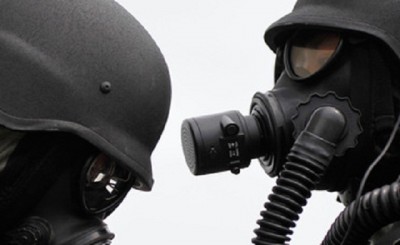Syria: Chemical Attack or “Provocation” by Opposition Rebel Forces

Early in the morning of August 21 in the Ghouta area, near Damascus, a chemical weapons attack with sarin nerve gas occurred, killing between 300 and 1.600 people. This attack was the largest-scale use of chemical weapons seen thus far in the armed conflict in Syria, so it could lead to all-out war in the Middle East – a danger that persists even now. The West categorically asserts that the Syrian National Army carried out the attack, and Western countries are demanding punishment for the ruling government in Damascus. Let’s attempt to sort through this issue based on the facts available.
At first glance, the American arguments are flawless. But some readily apparent vexing details permit doubts about the veracity of those arguments. First, let’s start by discussing the caliber of the chemical weapons delivery systems. According to UN chemical weapons inspectors, unguided 140 mm rockets were used in the attacks. The UN inspectors suggested that Soviet BM-14-17 (MLRS) rocket launchers were used. However, Syria long ago removed those systems from its arsenal, and the army does not use them. They were replaced by modern Soviet 122 mm “Grad” (MLRS BM-21) and Chinese 107 mm Type 63 light rocket launchers. Syria may have also used 220 mm Soviet-made Hurricane rocket launchers (MLRS 9P140).
So how did the obsolete MLRS BM-14-17 systems get there? Perhaps they came with the rockets supplied by external opposition supporters who had previously obtained those sorts of weapons from the Soviet Union. As an alternative explanation, one cannot exclude the possibility that the opposition captured the munitions from Syrian weapons depots that might have held them.
In contrast to the Syrian army, the armed opposition is willing to use any weapons, including obsolete ones, just to seize power. The fact that the casualties include women, the elderly and children doesn’t matter to the radical opposition. This is evidenced by the recent killings first of 450 Kurds and then of more than 500 Alawites. The Syrian army behaves differently. It does not wage war on defenseless civilians.
Second, it is still impossible to accurately determine who carried out the chemical attack in Guta based on the geographical placement of the rocket launchers. Several types of rocket launcher can be covertly deployed between a Syrian military base and the site of the chemical attack, even with uninterrupted satellite surveillance. Considering that the attack took place in the early morning, the rocket launchers could have been moved under the cover of darkness using the blackout mode.
Third, rockets with an extremely long period of viability were used in the attack. Thus, judging from the markings on one of the unexploded rockets, an expert at the Center for the Study of Strategy and Technology, Mikhail Barabanov, concluded that the projectile had been produced in 1967 at Factory No. 179 (now the “Sibselmash” production facility in Novosibirsk). The obvious question is, “Why would the Syrian army use such old and unsafe rockets in its chemical operations?”
It should also be noted that Syria didn’t begin producing chemical weapons until the 1990s, following the establishment of manufacturing facilities in the mountainous region near Damascus, and at petrochemical plants in Homs (VX gas), Hama (sarin, tabun and VX gases) and Aleppo. Rockets can be outfitted with chemical weapons, but the time frame in which they were rolled out must match the timeline for production of chemical weapons, not be off by 25 years.
Fourth, U.S. officials rule out the possibility that the armed opposition has chemical weapons. This contradicts the available facts. For example, on March 19 2013, the opposition used sarin in an attack with a self-produced missile.
On May 30 this year, security forces in Turkey intercepted a car carrying 2 kilograms of sarin gas. They also arrested 12 members of “Jabat en-Nusra”, an organization with close ties to Al-Qaida.
Russia possesses information showing that members of the opposition in Syria and Turkey tried to buy 10 tons of chemical weapons components.
Fifth, the UN inspectors found a more potent form of sarin than that used by Saddam Hussein against the Kurds in 1988, yet there was no evidence of Syrian army involvement in the attack. That kind of weaponry might have been made recently with modern technology outside Syria. It must first be ascertained whether the sarin used in the attack exists in Syrian army stockpiles, and only then conclusions can be drawn about who used chemical weapons.
Sixth, the necessity of diffusing liquid sarin through the air can in no way preclude opposition involvement in the attack. Opposition fighters could have easily fired the projectiles from rocket launchers on the upper floors of buildings and equipped them with makeshift warheads.
Seventh, senior Syrian army officials’ radio transmissions intercepted by the Americans do not provide evidence of their decision about the military’s use of chemical weapons. Moreover, President Assad has forbidden them from doing so. The possibility that Syrian military personnel acted at their discretion in this regard does not appear strong in light of the fact that the army’s actions are monitored by the secret services.
In short, the U.S. could not provide conclusive evidence that Syrian National Army forces used chemical weapons against civilians in Guta on August 21. In particular, the means of delivering the chemical weapons were not possessed by the Syrian army, and the opposition could easily have obtained sarin gas. We can thus assume that in this instance the armed opposition carried out a massive provocation against Bashar al-Assad aimed at violently overthrowing him, with the means of American armed forces and their allies.
Vladimir Yevseyev, the Director of the Center for Social and Political Studies, exclusively for the online magazine ”New Eastern Outlook”.

